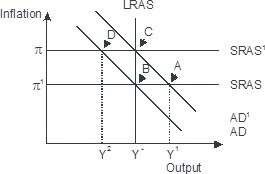Based on the figure below. Starting from long-run equilibrium at point C, a tax increase that decreases aggregate demand from AD1 to AD will lead to a short-run equilibrium at point ________ and eventually to a long-run equilibrium at point ________, if left to self-correcting tendencies.
A. D; C
B. D; B
C. A; B
D. B; C
Answer: B
You might also like to view...
The schedule of tolls capable of maximizing the net revenue of a bridge owner
A) has no relationship to the cost of constructing the bridge. B) is the highest anyone will pay rather than forgo the opportunity to cross the bridge. C) varies proportionately to the cost of constructing the bridge. D) will be higher than the corresponding tolls for a tunnel, because tunnel construction costs must be sunk rather than elevated.
Ricardian equivalence argues that when the government cuts taxes and raises its deficit,
A) consumers anticipate that they will face lower taxes later to pay for the resulting government debt. B) consumers anticipate that they will higher services from the government. C) consumers anticipate that they will face higher taxes later to pay for the resulting government debt. D) consumers anticipate it will affect their future taxes, in general in the direction of lowering future taxes. E) consumers anticipate that the low tax rates will continue.
There is an empty lot between a playground and a storage unit that has become filled with garbage and overgrown weeds. The lot is surrounded by a fence with a gate. Pipes run beneath it so that anything built there could have access to the city sewer and water supply. Which aspect of the empty lot would economists label as “bads”?
a. the access to water and sewer b. the proximity to the playground and storage unit c. the garbage and weeds d. the fence and the gate
Which of the following is true for perfect competition but not true for monopolistic competition and monopoly?
A. P = MC and positive long run profits B. Positive long run profits C. P = MC D. MC = MR